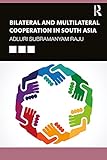Bilateral and Multilateral Cooperation in South Asia / edited by Adluri Subramanyam Raju.
Publisher: Abingdon, Oxon ; New York, NY : Routledge, 2022Description: 1 online resourceContent type:- text
- computer
- online resource
- 9781000452877
- 9781003145271
- 320.540954 RAJ 23
- JZ1720
| Item type | Current library | Shelving location | Call number | Status | Date due | Barcode |
|---|---|---|---|---|---|---|
 BOOKs
BOOKs
|
National Law School | MPP Section | 320.540954 RAJ (Browse shelf(Opens below)) | Available | 38683 |
Contents
Contributors;
Acknowledgements;
Introduction;
PART 1 Regionalism and multilateralism in South Asia: Background;
1 Options in economic cooperation: Background;
2 Regionalism and multilateralism: Contradictory or complementary?;
3 Limits of multilateralism in South Asia;
PART 2 Regional cooperation in South Asia and beyond;
4 Migration and refugees in South Asia;
5 Terrorism and regional cooperation: What is SAARC up to?;
6 Connecting South Asia through sub-regional initiatives: A case study of (B)BIN MVA;
7 India’s new regionalism in South Asia: Changing dynamics and patterns;
8 India looking beyond SAARC: Is it benefiting?;
9 BIMSTEC: India’s options for stepping beyond regionalism;
10 India: Multilateral and bilateral engagement with ASEAN;
11 Regional groupings: Sri Lanka as a troubled island nation;
PART 3 Bilateralism in South Asia;
12 India–Bangladesh connectivity: A critical appraisal;
13 India–Pakistan relationship: Nuclear as a factor;
14 Understanding the Afghanistan conundrum: Implications for India;
15 “Pashtun” factor in Afghanistan–Pakistan relations;
Index
"This book examines how bilateralism and multilateralism serve as cornerstones in bringing countries together to enhance regional cooperation. It explores the unfolding dynamics of bilateral and multilateral relationships in South Asia and looks at how factors like absence of shared identities or common threats from external sources, lack of trust, and suspicion are manifesting as obstacles for regional cooperation in the region. With case studies from various constituent countries, the volume studies themes such as economic cooperation in South Asia, connections through sub-regional initiatives, migration and refugee problems in the region, SAARC and terrorism, the Pashtun factor in Afghanistan-Pakistan relations, India's interests in ASEAN and BIMSTEC, nuclear dynamics of India-Pakistan relations, India-Bangladesh connectivity issues, Sri Lanka as a troubled island nation, and Afghanistan's relations with the Kashmir valley. It discusses implications of these long-standing issues that have stood as impediments in regional cooperation and in bringing new perspectives to enable greater understanding and probable solutions. A comprehensive and accessible volume, It will be useful for scholars and researchers of international relations, international trade, South Asian studies, SAARC, regional development, international and multilateral trade, political studies, geopolitics, strategic and defence studies, and peace and conflict resolution"-- Provided by publisher.
Description based on print version record and CIP data provided by publisher.

There are no comments on this title.